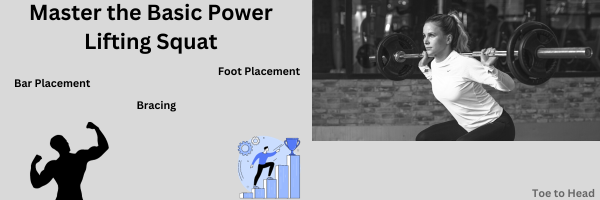Introduction:
Powerlifting is a strength sport that comprises three primary lifts: squat, bench press, and deadlift. Among these, the squat is often considered the king of lower body exercises. If you’re looking to excel in powerlifting or simply want to improve your squat strength, this guide will walk you through the essential techniques, tips, and training strategies to help you powerlift squat effectively and safely.
Master the Basics of Powerlifting Squat:

Before diving into advanced techniques, it’s crucial to understand the fundamental principles of powerlifting squats:
- Foot Placement: Start with your feet shoulder-width apart. Experiment with different stances to find what’s most comfortable for you, but a slightly turned-out position is common.
- Bar Placement: The bar should rest across your upper back, not your neck. High-bar and low-bar squats are the two most common variations.
- Bracing: Take a deep breath before each squat and hold it until you return to the starting position. This helps stabilize your core and protect your lower back.
Perfect Your Form:
A key component of effective powerlifting squatting is maintaining proper form. Here are some form tips to keep in mind:
Neutral Spine: Keep your back straight, chest up, and maintain a neutral spine throughout the movement to avoid excessive stress on your lower back.
Depth: Powerlifting squats require breaking parallel, meaning your hips should descend below your knees. This ensures that you’re engaging your muscles fully.
Knee and Hip Alignment: Your knees should track in line with your toes to avoid unnecessary strain on the joints.
Hips Back and Down: Initiate the squat by pushing your hips back and then bending your knees. This distributes the load properly.
Strength Development:
Powerlifting squats demand significant lower body strength. To build this strength effectively, consider the following training strategies:
- Progressive Overload: Continuously increase the weight you lift over time. This gradual increase challenges your muscles and stimulates growth.
- Squat Variations: Incorporate variations like front squats, box squats, and pause squats to target different muscle groups and break plateaus.
- Frequency: Squatting 2-3 times a week is common in powerlifting programs to maximize strength gains.
Warm-Up and Mobility:
Proper warm-up and mobility work are essential to prevent injuries and enhance your squatting performance:
- Dynamic Warm-Up: Start with 5-10 minutes of light cardio, followed by dynamic stretches like leg swings and hip circles.
- Mobility Drills: Perform mobility exercises for your hips, ankles, and thoracic spine to ensure a full range of motion.
Breathing and Bracing:
Mastering your breath and bracing technique is critical for a strong squat:
- Breathing: Inhale deeply before the descent, hold your breath as you squat, and exhale at the top. This breath-holding technique provides stability.
- Core Bracing: Tighten your core as if you’re preparing for a punch in the stomach. This bracing protects your spine during heavy lifts.
Proper Equipment:
Investing in the right equipment can significantly impact your squat performance:
- Weightlifting Shoes: Weightlifting shoes with an elevated heel provide better ankle mobility and stability during squats.
- Lifting Belt: A lifting belt can help support your core and prevent lower back injuries during heavy squats.
Recovery and Rest:
Give your muscles time to recover between squat sessions. Adequate rest and nutrition are crucial for muscle repair and growth.
- Sleep: Aim for 7-9 hours of quality sleep each night to aid recovery.
- Nutrition: Consume enough protein and calories to support muscle repair and growth.
Seek Professional Guidance:

Consider working with a qualified powerlifting coach or trainer. They can provide personalized guidance, form correction, and tailored training programs to help you reach your squatting goals.

What is the squat rule for powerlifts?
The squat rule in powerlifting specifies that the lifter must descend until the top surface of the legs at the hip joint is lower than the top of the knees. In other words, the hip crease must be below the knee crease for the squat to be considered a valid lift during a powerlifting competition. This is often referred to as “breaking parallel.”
How deep should you squat for powerlifting?
In powerlifting, you should aim to squat to a depth where your hip crease is below the top of your knees. This is often referred to as breaking parallel. It ensures that you are achieving the required depth for the lift to be considered valid in competition. Going deeper can provide an advantage as long as you maintain proper form.
How do you train to powerlift?
Training for powerlifting typically involves a combination of strength and technique work for the three primary lifts: squat, bench press, and deadlift. This includes progressive overload, periodization, and specific accessory exercises to target weaknesses. A structured training program and proper nutrition are essential for success in powerlifting.
Why can’t I squat deep?
Inability to squat to the required depth may be due to various factors, including mobility limitations, muscle imbalances, or poor technique. Working on hip, ankle, and thoracic spine mobility, as well as strengthening the necessary muscle groups, can help improve squat depth. Consider consulting with a coach or physical therapist for personalized guidance.
What is Arnold Schwarzenegger’s max squat?
Arnold Schwarzenegger’s maximum squat is not widely documented, as he is more famous for his bodybuilding career. However, it’s known that he had impressive strength in addition to his bodybuilding achievements. Specific records of his maximum squat weight may not be readily available.
What is the 100 squats a day rule?
The “100 squats a day” rule is a popular challenge or fitness trend where individuals aim to perform 100 squats daily. While it can be a good way to build lower body strength and endurance, it’s essential to start with an appropriate number of squats based on your fitness level and gradually increase the reps. Form and technique should always be a priority to avoid injury. This challenge can be a part of a broader fitness routine but shouldn’t be the sole focus of one’s exercise regimen.
Conclusion:
Powerlifting squatting is a rewarding endeavor that requires dedication, proper technique, and consistent training. By mastering the basics, focusing on form, progressively increasing your strength, and ensuring proper warm-up and recovery, you can achieve significant progress in your powerlifting journey. Don’t forget to listen to your body, seek professional guidance when needed, and stay patient in your pursuit of a powerful squat. With dedication and the right approach, you can reach new heights in your powerlifting performance.



